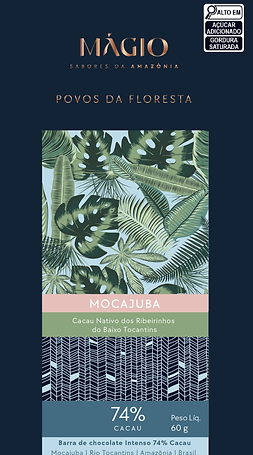


Chocolate Mocajuba - 74% Cocoa
Geographical coordinates of the cocoa harvesting location: 2° 33′ 57′′ S | 49° 31′ 36′′ W
Mocajuba - Tocantins River - Pará - Amazon - Brazil
Harvested by the riverside people of the São Joaquim River Association, on the banks of the river Tocantins, in the municipality of Mocajuba, the Pará variety cocoa presents specificities of this sandy floodplain biome, which give it a sweet and nice to chocolate. Its flavor is reminiscent of banana and offers notes ranging from honey to dry fruits. It is delicate and persistent. This chocolate bar also features flavor of Brazilian history, since it was around Mocajuba one of the first milestones in the export of cocoa from Brazil to Europe in the 18th century.
Planted by the Jesuits and harvested by the indigenous people, Cametá cocoa beans, as the city of Mocajuba in Pará was called at the time, offer a different flavor not only due to the region’s most sandy lowland biome, but also due to its importance in history. Brazilian. The name of this chocolate bar celebrates the history of cocoa in Brazil. Did you know that the first cocoa export to Europe came from that territory?
During the period of the Portuguese empire in the country, a shipment of cocoa departed from Belém/Cametá, more precisely from the state of Maranhão and Grão-Pará, as the region that covered from the state of Ceará to the extreme north of Brazil became known, to the France. In the search for cocoa in the 18th century, the French built a boat that was named “Belém” and which still remains in Mocajuba today, reminding everyone of the history of this place of indescribable beauty, in addition to the history of Brazilian cocoa.
It is precisely because of its origin that the cocoa from this primary and dense forest is called the Pará variety. São Joaquim, which currently has 250 members (ribeirinhos, rubber extractivists, andiroba, açaí and cocoa) and, under the coordination of Emiliano Dutra Sepeda, is an example of structure and organization.
In addition to the taste of bananas and notes that range from honey to dried fruits, this chocolate with a sweet and pleasant aroma has, above all, a taste of history: the history of our country and also of the chocolatier César De Mendes, since his father was born and raised. right in Cametá. Much of the delicacy and persistence of this chocolate arises beyond the sensory notes of its cocoa, but is found in the sweet memories and personal stories of the founder of De Mendes and the first cocoa exports from Brazil.




SOCIAL AND ENVIRONMENTAL IMPACT
This product directly impacts 1,000 people and helps keep 10,000 hectares of forest standing. From harvesting to production, we seek to be responsible, supportive and socioeconomically fair.
OTHER INGREDIENTS AND SUPPLIERS *
- Brown Sugar: supplied by COPAVI – Cooperativa de Produção Agropecuária Vitória, located in Paranacity, in the northwest of the state of Paraná. Founded in 1993, from the Santa Maria settlement, with just 236 hectares and 61 inhabitants, COPAVI is the longest-running experience in collective and solidary production in Paraná.
* possible changes in the supplier may happen due to the availability of the product.



